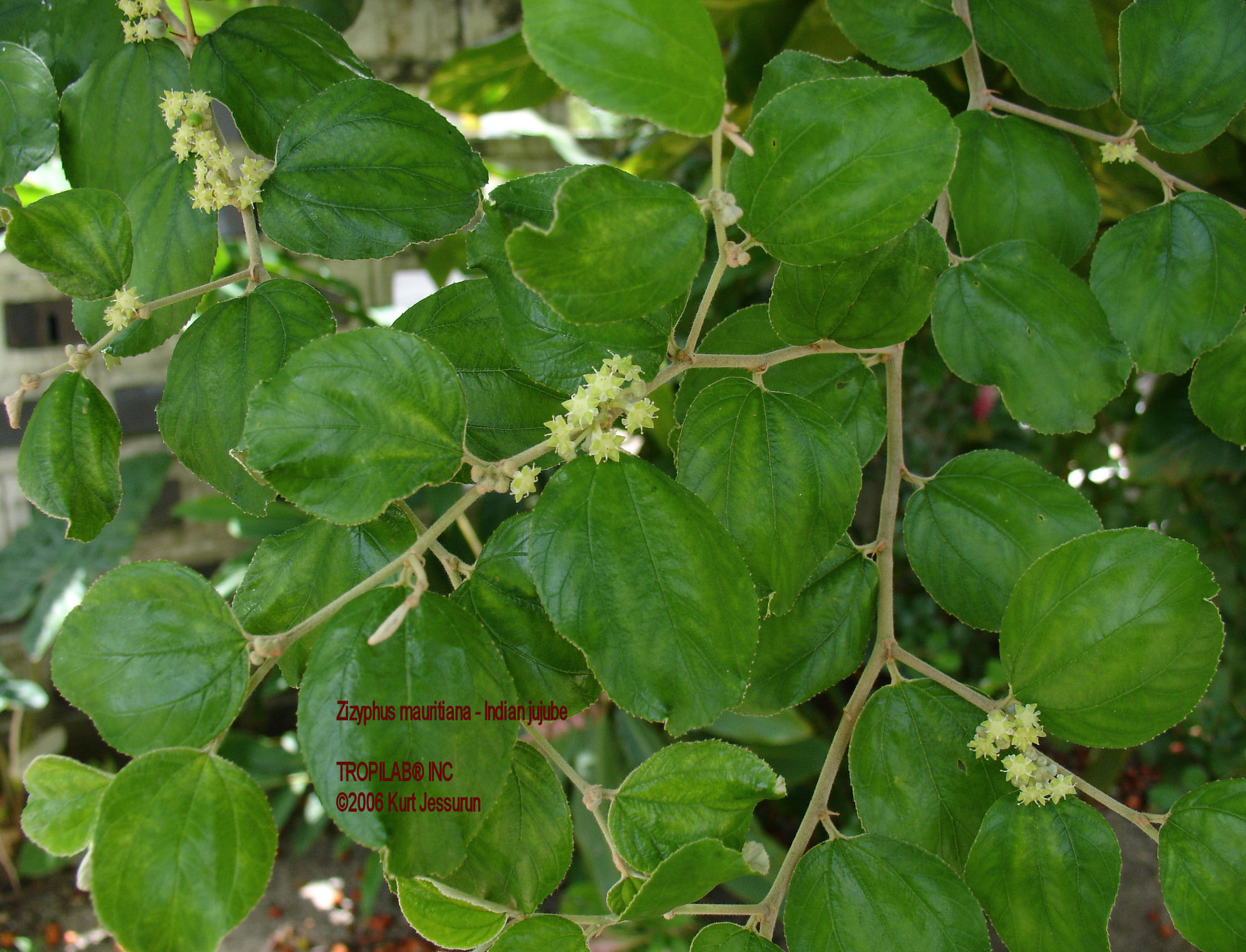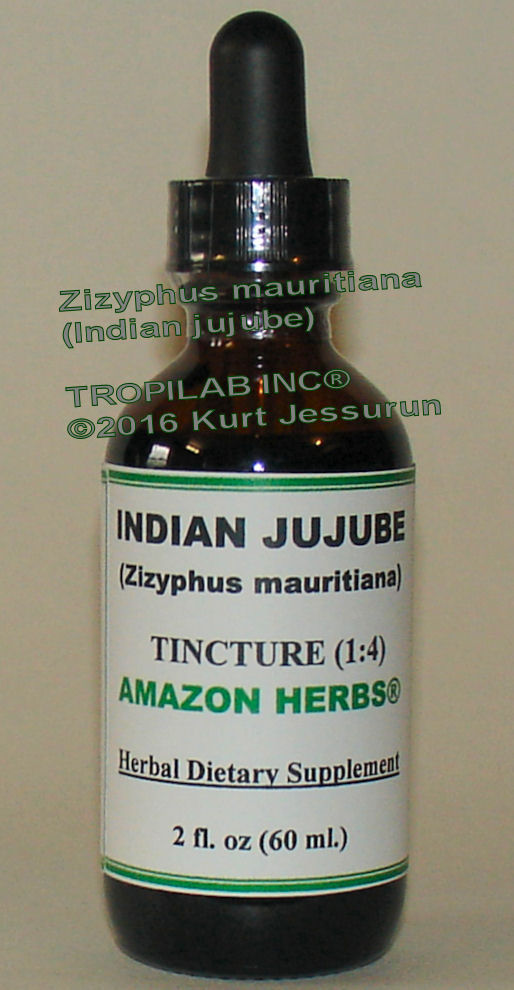Overview
 Indian jujube is a small - to medium sized tropical tree, it can grow
up to 25 ft. The tree can withstand extremely hot temperatures, as well as cold temperatures up to - 25 F.
Indian jujube is a small - to medium sized tropical tree, it can grow
up to 25 ft. The tree can withstand extremely hot temperatures, as well as cold temperatures up to - 25 F.
Research has shown that Indian jujube increases immune-system resistance.
The root is used in the treatment of dyspepsia (indigestion) and decoctions of the root can be employed in the treatment
of fevers.
The plant is a folk remedy for anemia, hypertonia (abnormal increase in muscle tension and reduced ability
to stretch), nephritis and nervous diseases. In China it is used as a treatment for burns (external).
Constituents
(% dry weight): crude protein, 12.9-16.9; fat, 1.5-2.7; fiber, 13.5-17.1;
N-free extract, 55.3-56.7; ash, 10.2-11.7; calcium, 1.42-3.74; phosphorus, 0.17-0.33; magnesium, 0.46-0.83;
potassium, 0.47-1.57; sodium, 0.02-0.05; chlorine, 0.14-0.38; Sulphur, 0.13-0.33%. They also contain
ceryl alcohol and the alkaloids, protopine and berberine, quercetin, kaempferol, sitosterol, stigmasterol,
lanosterol, diosgenin.
Pharmacology
 Wild jujube (Ziziphus jujuba) has sedative and tranquilizing properties.
Wild jujube (Ziziphus jujuba) has sedative and tranquilizing properties.
It is used in formulas where the prime symptoms are: insomnia, night sweats, palpitations and nervous body movements. This seed also
has analgesic properties and is an anticonvulsive (antiepileptic, anti-seizure).
It is also thought to supply necessary nutrients directly to the heart.
In traditonal medicine, several plants were used in diabetes treatment. Among them, the aqueous extract
from the leaves of Zizyphus mauritiana was studied. The extract was administrated per os to Wistar
rats made diabetics either temporarily by oral glucose tolerance test (first case) or definitely by subcutaneous
injection of alloxan (second case). It was observed to have a striking decrease of the hyperglycemic arrow (p < 0.05)
in the first case, with 300 mg/kg administrated 90 minutes before starting the test. In the second case,
the results obtained with a dose of 300 mg/kg once or twice a day were identical as those with glibenclamide (medication to treat
diabetes type 2) at 0.2 mg/kg per day. So, the antidiabetic activity was experimentally born out but it has to be standardized
for common use.
The phytochemical Betulinic acid is abundantly found in the Jujube fruit, which is known to exert an anti-melanoma activity
by causing apoptosis (programmed cell death) against cancer cells. In another recent study, the fruit extract was found to be
effective for inhibiting the tumor cells and cells that can lead to leukemia. Jujube extract inhibited tumor cell proliferation in
all lines but displayed the greatest effect against Jurkat leukemia cells.
Saponins in Jujube extracts have hypnotic and sedative effects, which may be precursors to elevated moods. This property is found to be
useful in combating depressive symptoms and mood swings. With its stress alleviating properties, it has been found to be useful for calming
the nerves and reducing anxiety. When the fruit extract was researched in some mentally ill patients, they were shown to have improved sleep
time. Patients were more active and it seemed to improve their mood. Jujube berry extract may be a natural alternative to prescription
anti-anxiety and sleep aids, more research is needed.
Applications
Indian jujube is used to cure stomach-aches, in the treatment
of syphilis, to calm intestinal irritations. Further for the treatment of respiratory ailments, throat,
intestinal, urinary inflammation and for constipation.
It is helpful in liver troubles,
asthma and fever. It has sedative properties and is effective against insomnia
and heart palpitations.
The bark is an effective astringent in dysentery and diarrhea; the fruit,
a mild laxative and expectorant.
The phytochemical betulinic acid, present in this plant, may be helpful
against melanoma cells.
Betulinic acid inhibits the growth of cancer cells.
Dosage
Tincture: 1 - 4 ml. daily
Reference
Allergenic Components of Indian Jujube (Zizyphus mauritiana)
Show IgE Cross-Reactivity with Latex Allergen
Mey-Fann Leea, Yi-Hsing Chenb, Joung-Liang Lanb, Chiang-Yuan Tsenga, Chii-Huei Wu
Acharya SB, Tripathi SK, Tripathi YC, Pandey VB (1988)
Some pharmacological studies on Zizyphus rugosa saponins. Indian J Pharmacol 20:200-202
Anonymous
(1976) The wealth of India. A dictionary of Indian raw materials and industrial products, vol XI:X-Z.
Council of Scientific and Industrial Research, New Dehli, pp 111-124
Arndt SK (2000)
Mechanisms of drought resistance in the tropical fruit tree Ziziphus. PhD Thesis, Vienna, 68p
Arndt SK, Clifford SC, Popp M (2001) Ziziphus - a multipurpose fruit tree for arid regions.
In: Sustainable land-use in deserts (Eds. Breckle SW, Veste M, Wucherer W). Springer, Heidelberg, Stuttgart,
New York. 388-399
Arndt SK, Kayser O (2001) Ziziphus - Eine Heilpflanzengattung mit Tradition und
Zukunft. Zeitschrift für Phytotherapie 22:98-106
Arndt SK, Wanek W, Clifford SC, Popp M (2000)
Contrasting adaptations to drought stress in
field-grown Ziziphus mauritiana and Prunus persica trees :
water relations, osmotic adjustment and carbon isotope composition. Aust J Plant Physiol 27: 985-996
Auvin C, Lezenven F, Blond A, Augeven-Bour I, Pousset JL, Bodo B, Camara J (1996) Mucronine J,
a 14-membered cyclopeptide alkaloid from Ziziphus mucronata. J Nat Prod 59:676-678
The above presentation is for informational and educational purposes only.
It is based on scientific studies (human, animal, or in vitro), clinical experience, or traditional usage.
For many of the conditions discussed, treatment with prescribed (RX) or over - the - counter (OTC) medication is
also available.
Consult your doctor, practitioner, and/or pharmacist for any health problem and before
using dietary supplements or before making any changes in prescribed medications.
|

